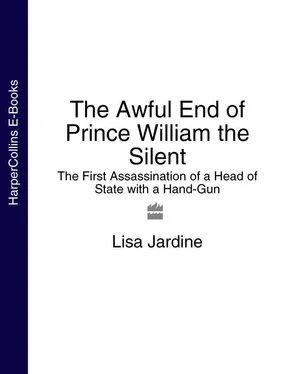It was not, however, until February 1582 that Anjou arrived in the Netherlands. William played a leading role in the warm reception given to him. He was the first to honour the new ruler by kneeling before him as the duke stepped on to the quayside at Flushing on 10 February. William was also prominent when Anjou was installed as Duke of Brabant at Antwerp nine days later. After the duke had sworn the required oath, William laid the crimson mantle on his shoulders, saying as he fastened it: ‘My Lord, this mantle must be well fastened so that no one can tear it off Your Highness.’ Anjou then rode through the richly decorated streets with Orange at his left hand. Along the route, triumphal arches and processional floats had been set up, representing the role it was hoped Anjou would play as defender of the country against tyranny and restorer of its peace and prosperity. At William’s insistence no expense had been spared in celebrating Anjou’s ‘joyous entry’. 20
To William’s profound disappointment, Anjou’s arrival did little to help build a more effective opposition to the Spanish forces, but instead widened the rift between Catholics and Protestants. Anjou’s own Catholicism and his insistence on public Catholic worship added to the widespread mistrust of his intentions, as did the fact that the duke had not after all brought with him the large army and financial aid that had been expected. On 18 March an unsuccessful attempt on William of Orange’s life was followed by violent reprisals against Anjou’s followers, who were believed to have conspired to kill the prince.
Undeterred, William, once he was on the road to recovery, pressed yet harder for consolidation of Anjou’s hold over Low Countries government. Anjou’s official installation went ahead on the Prince of Orange’s own insistence. If the purpose of the 1582 assassination attempt was to prevent the Franco-Dutch alliance, it failed, just as it had, remarkably, failed to end William’s life. It is hard at this point to see why William continued to press for Anjou’s settled sovereignty. According to his brother, Count John of Nassau, William believed that he could thereby engineer political confrontation between France and Spain, diverting Spanish forces and perhaps Parma from making continued gains in the Low Countries. But however strategically desirable, William’s dogged defence of Anjou was increasingly unpopular.
Meanwhile Anjou’s own frustration intensified as he awaited the required formal consent of the Dutch people. Finally, he took matters into his own hands. When military reinforcements arrived in January 1583 under their French commander he decided to take effective power over Brabant and Flanders by means of a military coup. Although William was warned by Duplessis-Mornay that Anjou was making treacherous plans to subvert his careful arrangements for the assumption of power, he chose to ignore him. Anjou entered Antwerp at the head of his troops, to the cry ‘Ville gagnée, vive la messe, tue, tue’ (‘The town is taken, long live the Mass, kill, kill’). He expected that his show of force would allow him to take the town without resistance. To his consternation, armed citizens blocked his way, and more than a thousand French troops, including many prominent noblemen, were killed as they fled; around a hundred citizens of Antwerp also lost their lives. After this ‘French Fury’ – which in its calculating callousness matched anything perpetrated by Alva or Parma in the name of Spanish rule – Anjou’s presence in the Netherlands was as much loathed and mistrusted as Philip’s had been.
Orange took no part in the defence of Antwerp, and was indeed implicated in Anjou’s attack. His fourth marriage, to Louise de Coligny on 12 April 1583, added to his growing unpopularity. Although she was the daughter of the great Huguenot commander assassinated at the outset of the St Bartholomew’s Day massacre, she was French by birth, and the union seemed to confirm William’s blind determination to forge lasting alliances between France and the Low Countries. In late July 1583, under mounting pressure, William withdrew to Holland, and took up residence in Delft. As confidence in his policy of support for Anjou seeped away, the prince’s loyal propagandists Marnix and Duplessis-Mornay quietly resigned and returned to their homes (Languet had died some years earlier). Anjou, chastened and dispirited by the fiasco of his second Antwerp entry, had meanwhile returned to France, leaving his French General Biron in charge of his troops. In June 1584, with negotiations still dragging on to determine the exact nature of Anjou’s sovereignty in the Low Countries, word came that he had died.
With no alternative candidate in sight, William was now persuaded to revive negotiations with the northern provinces for his own nomination to the title ‘Count of Holland and Zeeland’ – an idea first proposed in 1581, and which would have regularised his now anomalous position as unappointed stadholder. Negotiations over the fine print of such an arrangement were still in progress when, on 1o July 1584, William the Silent was shot and killed by an assassin in his Delft home.
A striking feature of William the Silent’s leadership of the Dutch Revolt is the significant part pamphlet publications by both sides played in the unfolding of events. A steady stream of passionate pleas on behalf of each party’s cause issued from European printing houses and circulated throughout Europe. Copies of a number of these survive in three or more languages (generally Dutch, French and English), thereby guaranteeing the broadest possible dissemination of the views expressed.
It is against this background of a propaganda war in which – unlike the war on the ground – the Protestant cause was winning hands down, that in 158o Philip II issued a proclamation inciting all good Catholics and all those loyal to the sovereignty of Spain to seek an occasion to kill William the Silent, and offering the successful assassin a reward of twenty-five thousand gold crowns, together with lands and titles. Like fatwahs before and since, the proclamation, which circulated widely in numerous European languages, was strategically counter-productive. The immediate response was the publication of William’s ‘Apology’ – a compellingly-written treatise in which the political theories of Marnix, Duplessis-Mornay and Languet fleshed out into respectability an open declaration of defiance of Spain and Spanish-imposed rule.
There is no doubt that William the Silent was the winner in this pamphlet war. Indeed, such has been the success of the picture painted by him, speaking in the first person (ghosted, probably, by Marnix, Villiers, Languet and Duplessis-Mornay), or by others speaking on his behalf, that it is hard to remember that at the time of his death William did not appear to all those around him as the irenic, tolerant and eminently reasonable man of the pamphlet characterisations. Nor did the Protestant cause he championed, and in which he remained resolutely supported by Queen Elizabeth I of England and her key ministers, Leicester and Walsingham, look as bright a prospect as it had in the 1570s.
On the contrary, by the time of William’s assassination many of those around him appear to have been ready to settle for peace at any price. For the first time pamphlets began to appear in which even convinced Protestants urged a reconciliation with Philip II. William himself wrote privately to the unwaveringly supportive Walsingham in January 1584 admitting that in spite of his bravado in public, his country was in a dreadful state:
I can assure you that the body of this state is much more gravely sick than appears on the outside, and that the evil has gone so far that the most vital organs have long ceased to function. I ask you to excuse me for so often behaving like the sick, who are ashamed to tell others of their complaints and even try to conceal them as far as they can from their doctors. 21
Читать дальше












